At the launch of the International Energy Agency (IEA)'s Southeast Asia Energy Outlook, Tim Gould, Chief Economist, IEA, shared key insights from the report.
His presentation explored the energy outlook for the region, examining key trends and the impact that Southeast Asia's rapid population growth will have on energy demand.

Rapid energy demand driven by urbanisation and transport
Southeast Asia's energy demand is surging due to rapid urbanisation and expanding transportation needs. The region's urban population increases by an amount equivalent to Singapore's population every year, a trend expected to continue through 2050.
This rapid growth places immense pressure on energy resources. With approximately 6,000 cars added daily to the region’s roads, and a sharp rise in air-conditioner use, residential and transport energy demands are intensifying.
Meeting this demand will require a comprehensive strategy that includes diversifying energy sources and bolstering the clean energy supply chain. As Mr Gould shared: "Southeast Asia’s growth story is central to our engagement with this region, and its energy demand is set to rise significantly in the coming years."
Accelerating clean energy in a fossil fuel-dominated market
Despite Southeast Asia’s reliance on fossil fuels, the region is moving towards cleaner energy. Eight out of 10 ASEAN countries have set net zero emission goals, with clean energy expected to account for over one-third of demand growth by 2035. Countries like Vietnam, Indonesia and the Philippines are leading this transition through investments in renewable energy, electrification, and energy efficiency.
According to Mr Gould, clean energy is set to grow significantly faster than in the past, thanks to higher renewables, more efficiency investments, and greater progress with electrification.
Challenges and opportunities in the energy transition
The clean energy transition faces significant challenges, particularly the need for large-scale investments in infrastructure such as power grids and energy storage. Many countries remain dependent on coal and other fossil fuels, but the shift present opportunities, including reducing costly oil & gas imports and mitigating energy price volatility.
Mr Gould says that investing in clean energy not only helps with emissions but also delivers energy security by lowering import bills. He stressed the need for coordinated efforts among governments, private sectors, and international organisations to mobilise capital and resources.
Southeast Asia’s energy transition is both challenging and yet full of potential. The region's rapid urbanisation will continue to drive demand, but with the right investments and policies, Southeast Asia can reduce its reliance on fossil fuels and strengthen its energy security.
Stay tuned for live updates! Follow @SIEW_sg on Telegram and Twitter for the latest as we dive into the conversations shaping Day 2.